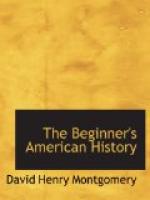He did not find the fountain, and so his hair grew grayer than ever and his wrinkles grew deeper. But in 1513 he discovered a land bright with flowers, which he named Florida.[4] He took possession of it for Spain.
The same year another Spaniard, named Balboa, set out to explore the Isthmus of Panama.[5] One day he climbed to the top of a very high hill, and discovered that vast ocean—the greatest of all the oceans of the globe—which we call the Pacific.
[Footnote 1: Ponce de Leon (Pon’thay day La-on’) or, in English, Pons de Lee’on. Many persons now prefer the English pronunciation of all these Spanish names.]
[Footnote 2: Balboa (Bal-bo’ah).]
[Footnote 3: De Soto (Da So’to).]
[Footnote 4: Florida: this word means flowery; the name was given by the Spaniards because they discovered the country on Easter Sunday, which they call Flowery Easter.]
[Footnote 5: Panama (Pan-a-mah’).]
29. De Soto discovers the Mississippi.—Long after Balboa and Ponce de Leon were dead, a Spaniard named De Soto landed in Florida and marched through the country in search of gold mines.
In the course of his long and weary wanderings, he came to a river more than a mile across. The Indians told him it was the Mississippi, or the Great River. In discovering it, De Soto had found the largest river in North America; he had also found his own grave, for he died shortly after, and was secretly buried at midnight in its muddy waters.
[Illustration: Burial of de Soto.]
30. The Spaniards build St. Augustine;[6] we buy Florida in 1819.—More than twenty years after the burial of De Soto, a Spanish soldier named Menendez[7] went to Florida and built a fort on the eastern coast. This was in 1565. The fort became the centre of a settlement named St. Augustine. It is the oldest city built by white men, not only in what is now the United States, but in all North America.
[Illustration: Old Spanish Gateway at st. Augustine. (Called the “City Gate.")]
In 1819, or more than two hundred and fifty years after St. Augustine was begun, Spain sold Florida to the United States.
[Footnote 6: St. Augustine (Sant Aw’gus-teen’).]
[Footnote 7: Menendez (Ma-nen’deth).]
31. Summary.—Ponce de Leon discovered Florida; another Spaniard, named Balboa, discovered the Pacific; still another, named De Soto, discovered the Mississippi. In 1565 the Spaniards began to build St. Augustine in Florida. It is the oldest city built by white men in the United States or in all North America.
What is said about a magic fountain? What did Ponce De Leon do? What is said about Balboa? What about De Soto? What did Menendez do in Florida? What is said of St. Augustine?
Sir Walter Raleigh[1]
(1552-1618).




